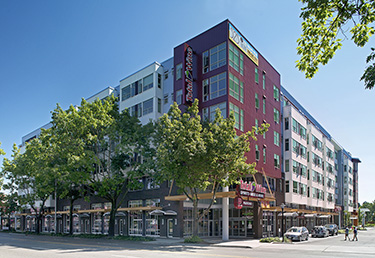|
Subscribe / Renew |
|
|
Contact Us |
|
| ► Subscribe to our Free Weekly Newsletter | |
| home | Welcome, sign in or click here to subscribe. | login |
Architecture & Engineering
| |
 |
October 26, 2017
How ‘affordable’ housing is disappearing in Seattle
Baylis Architects

Wagner
|
It’s difficult to write about affordable housing in metro Seattle at a time when we all know that there really is no such thing. That said, our industry needs to continue to explore how we can offer “less” expensive housing — housing that is at least “more” affordable.
There is no one solution, but through many small improvements, the collective can make considerable progress.
Recent successes
The actual cost of housing, including construction materials and labor, permits and mitigation fees, professional fees, insurances, etc. are all important elements. Our private sector industry has made amazing progress in keeping these costs as low as possible. Construction methods such as prefabrication and panelization, development of new materials, and advancements in low-voltage controls and mechanical systems have all kept the costs of construction at a minimum. And the percentage of professional fees are actually lower than they were years ago, driven by new delivery methods and software.
On the municipal side of the housing cost formula, many of our local jurisdictions now provide for multifamily tax exemption programs, which are a great start and have already provided hundreds of more affordable units. And the HALA members deserve a shout-out for their success in recommending necessary compromises.
But so much more must be done.
Housing expectations
Let’s start with our own expectations. These are a huge contributor to our limited affordability. When did we decide that a child needed her own bedroom or his own bath? When did we all want a den, a big pantry, a media room?
In the single-family market, new homes were about 1,400 square feet in the 1970s; today the average is pushing 2,400 square feet. That’s a 70 percent increase! And even then, we park our cars on the street and in the driveways, because our garages are so full of stuff.
In the multifamily market, especially in condominiums, our space demands have similarly expanded. But in our market rate multifamily, our demands are already changing. Certainly driven by rising rents, we find that many of us are accepting smaller living units and the demand for even smaller units continues to grow, especially in the singles tech market where high rent is preferred over roommates. Truth is, our millennials may have the answer here: move out of your parents’ home and into an apartment that’s only a little bigger than your bedroom!
Land use, building codes
Code and ordinance requirements are another contributor to the lack of affordability. Yes, our buildings today are much safer, more energy efficient and more sustainable, but do we truly understand the trade-offs of each of these improvements, which unquestionably and individually drive up the cost? Each of these has been debated and adopted through an exhaustive process, but questions remain.
Land-use codes help maintain neighborhood character by intentionally defining density. But limiting density sacrifices the neighborhood retail and services and supports gentrification. Single-family lots as small as 3,500 square feet and cottage housing, both with on-site parking, offer solutions but are not generally embraced by land-use codes.
Our energy codes come in many versions and each year get more demanding of all forms of housing. Our air infiltration codes have made our building envelopes so impenetrable that we need mechanical assistance to keep the interior air breathable. Yet, in the subsidized housing market, the Evergreen Sustainable Development Standard has served amazingly well in reducing energy demands for many years.
Having an ADA-compliant living space is something we will all require sooner or later, but these ADA requirements can add more than 10 percent to the square footage of dwelling unit. Must every multifamily unit meet these standards?
Our design review processes allow for the neighborhood to understand the proposed project, but the level of detail, too often to the level of the entry door color, adds time — a lot of time!
It’s easy to argue that if the cost of construction is rising 12 percent a year and the permit approval process adds six to 12 months, the cost to develop and the cost to rent will increase. Some good news here: many jurisdictions are reviewing these processes, including the city of Seattle, and there are many good ideas, so let’s be hopeful! The next challenge will be enforcement by staff in the public realm and a balanced understanding by staff of the needed scrutiny.
New priorities
If affordability is truly our priority, other ideas need to be put into play. If affordable housing was as high a priority as other public services, we citizens would be ready to do our part.
Through many public programs, we already provide subsidies, waivers and credits for “subsidized” housing at 30, 60 and even 80 percent of area median income, but these are only available to those of us who’ve already fallen off the economic cliff. Can we do more for those that are teetering?
Sales tax, B&O tax, excise tax, sewer capacity charges, impact fees and many more fees and changes are all contributors to the lack of affordability, and each might be waived or reduced to recognize our commitment to affordability.
Broader perspective
From a broader perspective, there are two other issues that should be considered in making our region more affordable. The first is our ability to pay for housing and the other is how we allocate our assets balanced by our lifestyle choices.
If we all had high-paying jobs, whether they are in tech, manufacturing, professions, etc., we could all afford our housing. As Jaebadiah Gardner notes, “People can’t afford to live in Seattle because they don’t have jobs that pay them enough.”
Getting trained for these jobs, investing far more in education and skills-building, would make housing more affordable. Those with higher education and training are not squeezed out. So we need to think of education and skills-training as part of our solution.
Another broader issue is our investment in mobility. We all complain about traffic, whether it is crowded roads or crowded buses. Yet one of the biggest drivers of our lack of mobility is that the cost of housing is forcing many to “drive ‘till you qualify.” There is a clear conundrum here, since those who move out, usually drive or bus back in every work day.
There is certainly a lifestyle choice working here. But beyond this choice, we now put billions into our transportation systems. Even if a small portion of these citizen dollars were invested in housing, we could take a BIG bite out of our affordable housing conundrum and a BIG bite out of our transportation sclerosis.
As we continue to strive for more affordable housing solutions, it’s important to recognize that there is not one overreaching solution, but many smaller solutions that contribute to the whole of our communities. Be sure to read up on the Master Builders Association’s new “10-Point Plan for Housing Attainability.”
Rich Wagner, AIA Fellow and managing partner at Baylis, has served as president of AIA/Washington, Renton Technical College Foundation and Wellspring Family Services. He is president of the Renton Community Foundation and was appointed to the Affordable Housing Technical Advisory Group of the city of Bellevue.
Other Stories:
- Ice Box Challenge: a cool test of Passive House
- Survey: Code Unlimited
- Survey: IA Interior Architects
- Surveys: NAC Architecture
- Survey: AHBL
- Survey: Lemons Architecture
- Is growth only benefiting a small segment in Seattle?
- Rock wool’s new role: protecting exterior wood stud walls
- Get ready for the new year — and new energy codes
- After 10-year engagement, Kinects inverts ‘wedding cake’
- WSU cultural center: ‘How are you going to build this?’
- High-performance building? Start with early design analysis
- How long will your AV last? Consider your cell phone
- Survey: Arup




